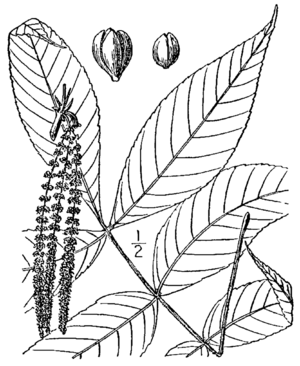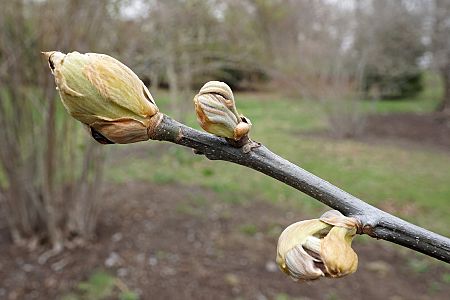Sand hickory facts for kids
Quick facts for kids Sand hickory |
|
|---|---|
 |
|
| Conservation status | |
| Scientific classification | |
| Genus: |
Carya
|
| Species: |
pallida
|
| Synonyms | |
|
Hicoria pallida, Hicorius pallida (Ashe) |
|
The sand hickory (Carya pallida) is a type of hickory tree. It grows naturally in the southeastern United States. This tree is a perennial plant, meaning it lives for many years. It likes to grow in rocky or sandy places. Sand hickory trees can grow very tall, sometimes up to 30 meters (about 100 feet). But usually, they are between 9 and 24 meters (30-80 feet) tall. When they grow in open areas, their tops are often tall and thin. The nuts from the sand hickory tree are safe to eat. Many animals enjoy eating them.
Contents
What Does the Sand Hickory Look Like?
The bark of a sand hickory tree changes as it gets older. When the tree is young, its bark is smooth. It is usually a light gray or brown color. As the tree grows older, its bark gets deep ridges. These ridges look like scales, and the bark turns a dark gray.
This tree has both male and female flowers on the same plant. This means it is monoecious.
Leaves and Branches
The leaves of the sand hickory are compound. This means each leaf is made up of several smaller leaflets. These leaflets grow in groups of 5 to 9, but usually there are 7. They are often oval-shaped. The main stem of the leaf (called the rachis) and the middle vein of each leaflet (called the midrib) are covered in soft, shaggy hairs. The underside of the leaves has tiny scales. These scales can look silvery-blue or silvery-yellow.
Like other hickory trees, the wood of the sand hickory is very strong and tough. It can absorb shocks well. The small branches, called twigs, are thinner than those of other hickory trees. The new buds are protected by shiny, mahogany-colored scales.
Roots and Planting
Carya trees, also known as "true hickories," have very long taproots. These are deep main roots that grow straight down. Because of these long roots, it can be hard to move or transplant a sand hickory tree. Many new trees do not survive when moved. So, if you try to plant one, you need to be very careful. The sand hickory can make a great shade tree or a special tree in a garden.
Flowers and Nuts
Male flowers, called catkins, are about 7 to 10 centimeters (3–4 inches) long. Female flowers are about the same size. The wind carries pollen from the male flowers to the female flowers. This is how the tree reproduces. Sand hickory trees bloom in the spring, from March to May. Their flowers can be yellow, green, or brown.
The nut of the sand hickory is oval-shaped and dark brown. It has a thin shell. The part inside the shell, called the kernel, is said to taste sweet. Small animals like rodents and squirrels, and large birds, all enjoy eating these nuts.
Where Does Sand Hickory Grow?
The sand hickory tree grows in many states in the southeastern United States. You can find it from Delaware all the way west to Missouri. It is not usually found in Pennsylvania, West Virginia, or Ohio. Sometimes, it can be seen in southwestern Indiana or Maryland, but it's not common there.
The number of sand hickory trees has been going down in some states. These include Arkansas, Illinois, Indiana, Louisiana, and Missouri. Sand hickory trees often grow in dry oak-hickory forests. You might see them growing next to longleaf pine trees (Pinus palustris) and scrub oak trees (Quercus marilandica). Sometimes, sand hickory trees can even mix with pignut hickory trees (Carya glabra).
How People Use Sand Hickory Wood
Hickory wood is very valuable because it is strong and useful. However, it takes extra time to work with because it is so dense. People use hickory wood for many things. These include flooring, cooking, making cabinets and furniture, and as firewood. It is also used for musical instruments and handles for tools. In the past, golf club handles were made from hickory. Because of its many uses, hickory wood is important for people who own forests and for the wood industry.
Amazing Sand Hickory Trees
In 2015, a very special sand hickory tree was found in Greenville, South Carolina. It was a "champion tree." This means it was one of the largest of its kind. The American Forests organization recorded it on their National Register of Champion Trees. This tree was 46 meters (150 feet) tall! Its top spread out 24 meters (80 feet) wide. As of 2020, this is the biggest known sand hickory tree.
Tree Health and Pests
The sand hickory tree can get a fungal disease called Downy Leaf Spot. This is caused by a fungus called Microstroma juglandis. When a tree has this disease, you might see light green spots on the top of its leaves. On the underside of the leaves, you might see white, floury, furry spots.
Other problems that can affect hickory trees include other fungi and insects. For example, hickory bark beetles (Scolytus quadrispinosus) and flat-headed wood borers (Chalcophora japonica) can harm them.
Gallery




